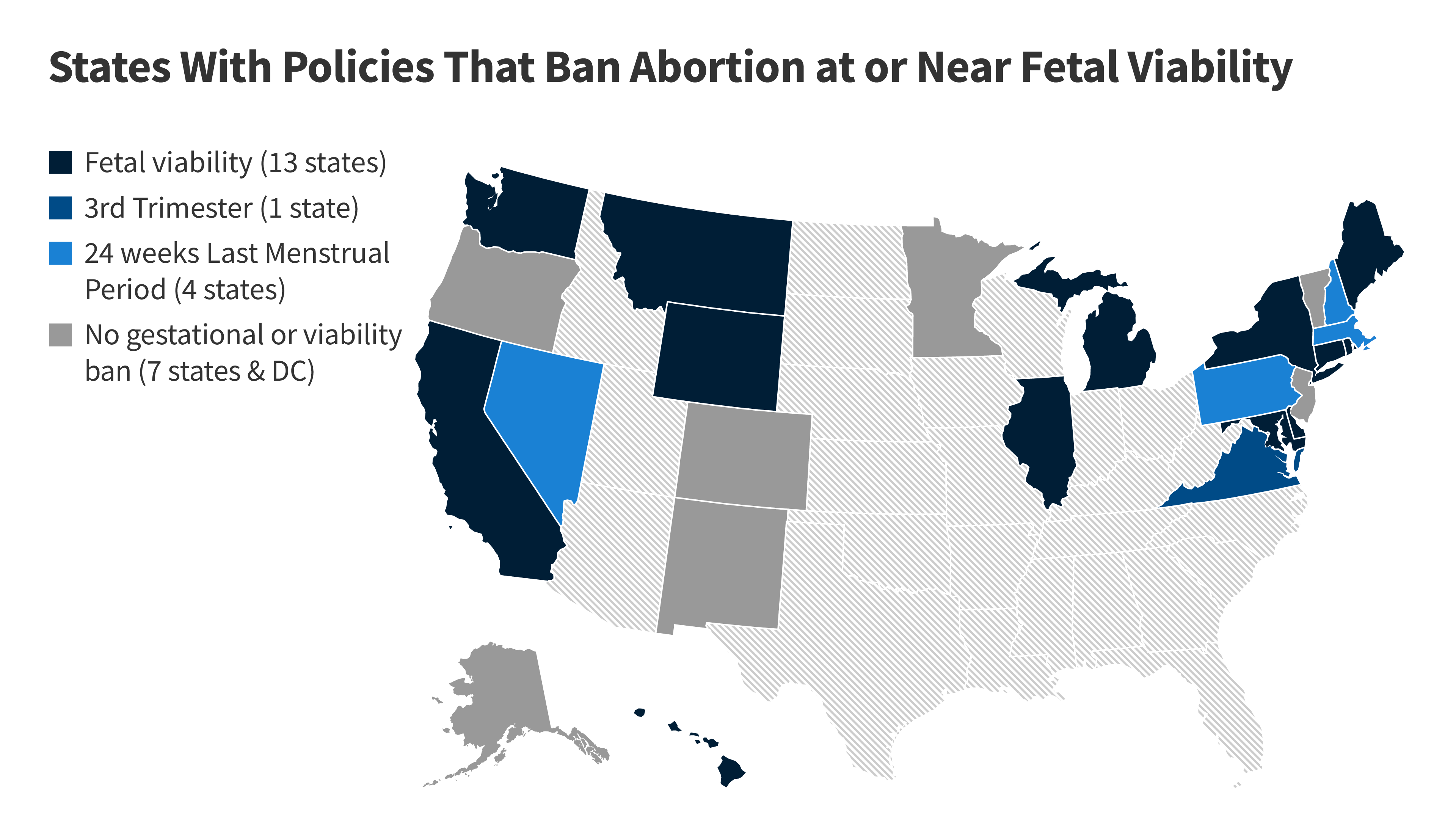I guess you don't understand what no restrictions mean. And ethics are in the eye of the beholder and an abortionist is in the business of abortion.
You find me the laws that say that its medically unethical to abort a healthy almost full term baby when their laws state that there are no restrictions. I think you're dead ass wrong.
I've read numerous sources and found no mention of restrictions based on health of the fetus or viability when the law states that there are no restrictions.
No restrictions mean no restrictions.
This conversation is stupid and pointless and born of right wing hysteria and lies
This brief explains why individuals may seek abortions later in pregnancy, how often these procedures occur, and the various laws which regulate access to abortions later in pregnancy across the country.

www.kff.org
Introduction
Abortions occurring at or after 21 weeks gestational age are rare. They are often difficult to obtain, as they are only available in a handful of states, performed by a small subset of abortion providers and are typically costly and time-intensive. Yet, these abortions receive a disproportionate share of attention in the news, policy and the law. Discussions on this topic are often fraught with misinformation; for example, intense public discussions have been sparked after several presidential candidates claimed there were abortions occurring “
moments before birth” or even “
after birth.” I
n reality, these scenarios do not occur, nor are they legal, in the United States.
Some states have also passed laws banning clinicians from performing certain abortion procedures that are commonly used in later abortions (
Figure 2). Almost all abortions performed at or after 21 weeks are performed by a dilation and evacuation (
D&E) procedure (
93–
95% per CDC data).
Abortions occurring at or after 21 weeks gestation are rare. According to the CDC’s Abortion Surveillance Data for 2021, prior to the
Dobbs decision, the vast number of abortions (96%) occurred at or before 15 weeks gestation, while 3% occurred from 16 to 20 weeks gestation, and just 1% of abortions were performed at or after 21 weeks (
Figure 3).
Clarifying Pregnancy Dating: pregnancies are measured using gestational age (GA), calculated in days and weeks since the first day of the last menstrual period (LMP). Since some people do not know the date of their LMP, ultrasound can also be used to calculate GA. Post-fertilization or fertilization age refers to the time since the egg and sperm fused to create a fertilized egg. Fertilization occurs approximately 2 weeks after menses, thus gestational age by LMP predates fertilization age by ~2 weeks. By convention, gestational age is used to discuss pregnancy dating as most pregnant individuals know their LMP, however certain abortion regulations reference fertilization age instead.
How do states restrict or regulate abortions later in pregnancy?
On June 24, 2022, in
Dobbs v. Jackson Women’s Health, the Supreme Court overturned
Roe and eliminated the federal constitutional standard that had protected the right to abortion. Without any federal standards, states can now set their own policies banning or protecting abortion at any point in pregnancy. This has drastically changed the landscape of abortion in the United States, as 14 states have now
banned abortion at any stage of pregnancy and 11 others have gestational limits banning abortion after a certain point in pregnancy, such as before cardiac activity is detected in the fetus or up to a certain number of weeks of pregnancy.
However, in states without abortion bans or gestational bans before 22 weeks LMP, access to abortions later in pregnancy is often limited for many reasons, including viability bans, bans on certain abortion procedures, and a limited number of abortion providers who are trained or willing to provide abortions later in pregnancy. While viability, the point when a fetus can survive outside the womb, is no longer the federal standard that defines the legality of abortion in the U.S., 16 states that still allow abortions currently have laws restricting abortion at “viability” or at 24 weeks LMP / 3rd trimester, when viability is presumed to occur (
Figure 1). These states have abortion exemptions similar to the
exemptions in abortion bans (such as to preserve the health or life of the pregnant person) and
gestational limits, defining when an abortion is allowed to be performed after viability. Most of the 11 states that restrict abortions at “viability” define it as the point where a physician or other healthcare provider determines whether a fetus can survive outside the womb. Four of these states include language in their abortion policies defining viability as the point where there is a likelihood that the fetus could survive
without the “application of extraordinary measures” and another three states have language clarifying the fetus could survive
with or without extraordinary measures.
How common are abortions later in pregnancy?
A
bortions occurring at or after 21 weeks gestation are rare. According to the CDC’s Abortion Surveillance Data for 2021, prior to the Dobbs decision, the vast number of abortions (96%) occurred at or before 15 weeks gestation, while 3% occurred from 16 to 20 weeks gestation, and just 1% of abortions were performed at or after 21 weeks (
Figure 3). This amounts to approximately 4,100 abortions per year occurring at or after 21 weeks. However, this estimate only includes the 41 reporting areas that report abortions to the CDC by gestational age and excludes major states such as California and New York. The percentage of abortions occurring at or before 13 weeks gestation has remained
stable over the last few decades at 91-92%, however within this timeframe, more abortions are occurring earlier in pregnancy, at or before 9 weeks. This is likely in part due to the greater availability of
medication abortions over the last two decades.
Why do people have abortions later in pregnancy?
Individuals seek abortions later in pregnancy for a
number of reasons. As part of the
Turnaway study out of the University of California San Francisco, from 2008-2010 over
440 women were asked about why they experienced delays in obtaining abortion care, if any (
Figure 4). Almost half of individuals who obtained an abortion after 20 weeks did not suspect they were pregnant until later in pregnancy, and other barriers to care included lack of information about where to access an abortion, transportation difficulties, lack of insurance coverage and inability to pay for the procedure.
A 2022 study of patients seeking abortions later in pregnancy found that they fell into two categories: either they had learned new information about their pregnancies that made them no longer desirable, such as not finding out they were pregnant until very late in the pregnancy or the emergence of serious fetal or their own health issue; or experiencing barriers to abortion services earlier in the pregnancy that force them to delay the abortion until the third trimester.
